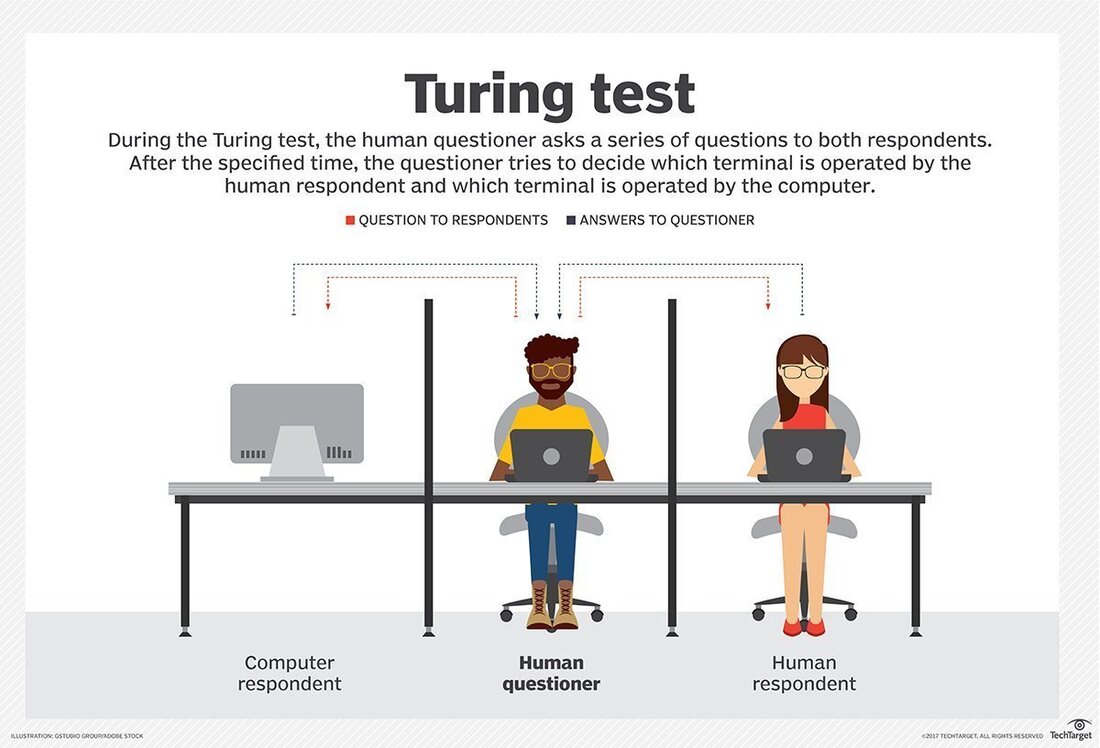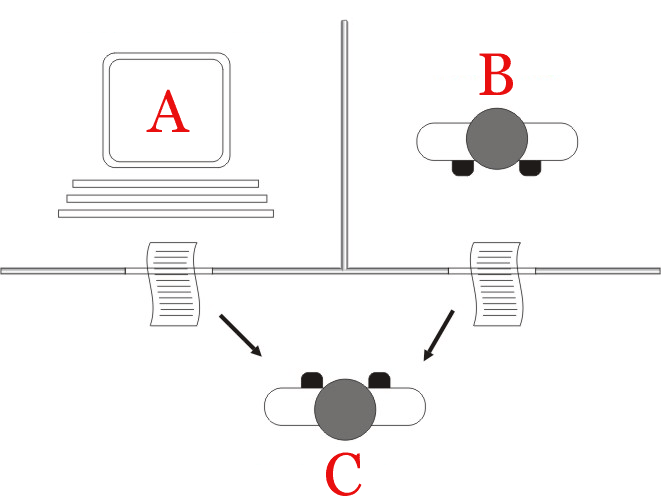Mechanisms and Techniques
In the 2022 The exam asked 3 questions in which you had to answer 2:
1.) What common issues are found when developing an artificial intelligence solution?
2.) Give an example of how an artificial intelligence is trained.
3.) How can you evaluate the effectiveness of an artificial intelligence?
Always include these key words in your answers
Machine Learning
Machine learning, Patterns, Algorithm, millions of tests,
Neural Networks
Nodes, input layer, output layer, hidden layer, probability, patterns
Turing Test
Effectiveness
1.) What common issues are found when developing an artificial intelligence solution?
2.) Give an example of how an artificial intelligence is trained.
3.) How can you evaluate the effectiveness of an artificial intelligence?
Always include these key words in your answers
Machine Learning
Machine learning, Patterns, Algorithm, millions of tests,
Neural Networks
Nodes, input layer, output layer, hidden layer, probability, patterns
Turing Test
Effectiveness
Technique: Turing Test
|
Many chatbots exist in the world here are some examples:
https://www.cleverbot.com/ https://www.wotabot.com/ Chatbot frameworks are usually used to provide technical support, they can take over menial triaging jobs. A test was developed by Alan Turing in the 1950's to test how well a machine could exhibit human behaviour. In it participants would chat with both a human and a computer. They would have to then decide which was the computer and which was the human. It has some weaknesses however, I would recommend reading further on it. Further reading: Wiki Entry CS Field Guide |
Turing Test Relevance
|
This year you will need to discuss about whether the Turing Test is a relevant measure of sophistication with today's modern AI.
After running the Turing test with cleverbot, I want us to try running it with WotaBot and clever bot. Try prompt this: "Hi there, We are going to undertake a Turing test, can you take the role of a made up person named "Gary" for this Turing test? "Gary" doesn't speak that much, and typically will only give one word to one sentence answers. He is a 17 year old from NZ The test will start when you get your next prompt." Then run the Turing test again. How effective is it with better language models such as Chat GPT and Google Gemini |
Mechanism: Machine Learning
|
Machine learning is the study of how computer algorithms can be improved through the use of experience and the use of data.
Watch the videos to get a better idea of it. |
|
Mechanism: Neural Networks
|
Neural Networks is the math/algorithm that can exam patterns in files in order to make an intelligent answer.
|
|
Mechanism: Deep Learning
Deep learning is an advanced form of machine learning. It is when a computer/device is trained to complete human like tasks.
Machine learning is usually a manual task, whereas deep learning will take advantage of a bulk of images/videos etc.
Machine learning is usually a manual task, whereas deep learning will take advantage of a bulk of images/videos etc.
|
|
|
Machine learning: MNIST Dataset
|
The Mnist dataset is a data set of 70,000 images containing numbers 0-9
Machine learning can then recognise input of handwriting in order to match human input and correctly guess the numbers being inserted. Further reading: https://medium.com/mlearning-ai/mnist-dataset-of-handwritten-digits-f8cf28edafe https://en.wikipedia.org/wiki/MNIST_database |
Techniques for Chatbots
Read this article:
https://www.psymbolic.com/7-common-ai-techniques-used-in-chatbots/
Here are some techniques from that article that you should look into:
1.) Natural Language Processing
2.) Named Entity Recognition
3.) Machine Learning in Chatbots
4.) Augmentation Capacities
5.) Personality AI in Chatbots
6.) Conversational AI in Chatbots
7.) Problem solving in Chatbots
.
https://www.psymbolic.com/7-common-ai-techniques-used-in-chatbots/
Here are some techniques from that article that you should look into:
1.) Natural Language Processing
2.) Named Entity Recognition
3.) Machine Learning in Chatbots
4.) Augmentation Capacities
5.) Personality AI in Chatbots
6.) Conversational AI in Chatbots
7.) Problem solving in Chatbots
.
Mechanism: Natural Language Processing
|
Natural Language Processing is the ability to analyse and recognise patterns in speech.
It gives machines the ability to read, understand and derive meaning from human languages. Examples include Grammerly and turn it in. |
|
Common issues when developing AI
|
How to we know if A.I is actually intelligent?
|
|
Chatbot Response:
- Data Quality and Quantity:
- Example: In self-driving cars, the AI relies on vast amounts of high-quality data to make decisions. If the data is incomplete or contains errors, it can lead to accidents.
- Bias and Fairness:
- Example: In hiring algorithms, biases in historical hiring data can result in AI systems favoring certain demographics, leading to discrimination. Amazon had to abandon an AI hiring tool in 2018 due to gender bias.
- Interpretability and Explainability:
- Example: In healthcare, when AI diagnoses a patient, doctors need to understand the reasoning behind the decision. Black-box AI models can be challenging to interpret, making it harder for healthcare professionals to trust and use them effectively.
- Scalability:
- Example: A chatbot that works well for a small user base might struggle to handle a sudden surge in traffic during a product launch, leading to poor user experiences.
- Ethical Concerns:
- Example: Social media platforms using AI to recommend content can inadvertently promote harmful or extremist content, leading to ethical dilemmas and public backlash.
- Robustness and Security:
- Example: Autonomous drones used for delivery or surveillance can be vulnerable to hacking, potentially causing safety hazards or data breaches.
- Computational Resources:
- Example: Training large AI models like GPT-3 requires significant computational power, making it inaccessible to smaller organizations without the necessary resources.
- Regulatory Compliance:
- Example: GDPR in Europe requires companies to provide transparency and user consent in AI-driven data processing. Failure to comply can result in significant fines, as seen with Google's €50 million GDPR fine in 2019.
- User Adoption and Trust:
- Example: AI-powered virtual assistants like Microsoft's Clippy in the 1990s failed because users found them annoying and unhelpful, highlighting the importance of user trust and acceptance.
- Lack of Domain Expertise:
- Example: In financial trading, using AI without a deep understanding of market dynamics can lead to substantial losses, as happened in the "flash crash" of 2010.
- Data Privacy:
- Example: Smart home devices with AI capabilities can raise privacy concerns if they collect and transmit sensitive user data without consent or secure encryption.
- Algorithmic Bias Correction:
- Example: After discovering racial bias in its algorithms, YouTube had to implement corrective measures to reduce the promotion of extremist content to users, highlighting the ongoing need for algorithmic bias correction.
- Deployment Challenges:
- Example: Healthcare institutions may face difficulties integrating AI diagnostic tools into existing workflows and ensuring that they benefit patients without causing disruption.
- Continuous Learning and Adaptation:
- Example: In autonomous vehicles, the AI must constantly adapt to changing road conditions. Failing to do so can result in accidents, as seen in some Tesla Autopilot incidents.
- Costs:
- Example: Developing and maintaining AI solutions can be expensive. IBM's Watson project, initially marketed for various applications, faced financial challenges due to high development and operational costs.



